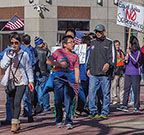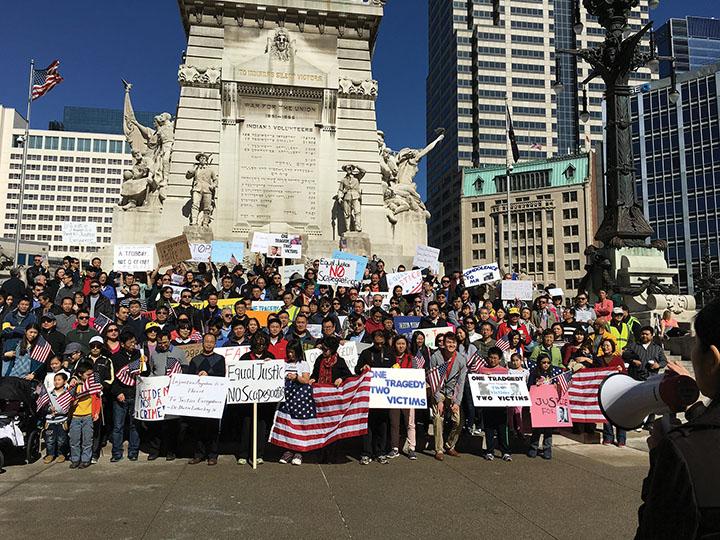Last year, thousands of Asian-Americans across the country gathered to voice their dissatisfaction over the conviction of N.Y.P.D. officer Peter Liang. Among them were Asian-American and sophomore Eric Ma and his mother Yonghao Hou, who took part in organizing the Indianapolis protest.
Ma said attending a protest like this made him realize the importance of standing up for his heritage.
“I mostly went because my mom was leading the protest, but I walked around the circle a few times with them, and they were chanting things like, ‘No scapegoating.’ I think that being part of Asian-American heritage, it’s important for me to stand up for my background, my ethnicity. Even though originally I didn’t want to go, it ended up being a good experience for me,” Ma said.
From the perspective of a parent, Hou said the protests represented a need to protect the interests for the next generation.
“As the first generation of immigrants, we’ve accepted that we are going to be treated differently because there was a huge gap that we needed to close in terms of the culture understanding and the language barrier and the social norms,” Hou said. “We are still trying to adjust. Maybe we will never adjust to the level of the second generation. But for the second generation to get this kind of selective treatment, you are killing the dreams of the second generation in front of the first-generation. It will make the parents desperate.”
These protests are long over, but the implications are not. According to the New York Times, the protests were a pivotal moment in the Asian-American history as national data rarely shows Asian-Americans protesting or even reporting hate crimes. AP U.S. History teacher Allison Hargrove said she agreed these protests were uncharacteristic of Asian-American behavior throughout history.

Asians march in Indianapolis, IN for Peter Liang. Hou said the purpose was to protect the interests of the next generation of Asian-Americans.
“Historically speaking, Asian-Americans have not had as significant protest groups. If you look at the major counterculture groups within the progressive era, and then you fast-forward to the 1960s, there were Asian groups that did protest, but as a whole it was not considered one of the mainstream or widespread protest groups. And so historically, that is not to say that Asian-Americans have not fought injustice in the past, it’s just not as one of the more well-known groups that protest,” she said.
According to Hargrove, this is because Asian-Americans do not protest due to social pressures and cultural differences.
“A lot of Chinese people who moved here, they felt that although they were facing discrimination, that life was better here than it was in China, so there was more of an appreciation there,” Hargrove said. “I think that the stereotype of the model minority, whether Asians feed into that idea or if that is something that is culturally derived, the idea that Asians just work hard, and are so educated, and make so much money, and give back to society, maybe there’s a fear to disrupt that stereotype. The concept of the model minority is something that I think is unfairly put on Asians, and a lot of people don’t recognize that that is something that can be very harmful.”
Hou said this is not what a model minority should be, and she believes Asian Americans can continue to be a model minority without suppressing their dissent.
“If you define a model minority as whatever people shove your way, you just accept it, without voicing any dissatisfaction, I don’t think that’s a model minority, that’s an oppressed minority,” Hou said.
As for future protests, Hou said she does not expect more dramatic movements anytime soon.
“Unless something more dramatic than Peter Liang (happens), I think the momentum will get lost. And we will probably get back to our own comfort zone of doing everything ourselves and then everything else the government will take care of. So I’m not optimistic.”
However, Hargrove said this does not necessarily mean Asian Americans cannot continue to have an increasing impact upon society; instead, Hargrove said she hopes Asian Americans will express their voice in the future through participation in the political and social climate.

“What I would love to see is an Asian Supreme Court justice; I would love to see more Asians represented in Congress, in our political leadership; definitely they are one of the most underrepresented groups in leadership positions,” Hargrove said. “My hope is that we do start to see a new youth generation, and a new generation of Asian kids that are more active in having their voices heard.”































![British royalty are American celebrities [opinion]](https://hilite.org/wp-content/uploads/2024/03/Screenshot-2024-03-24-1.44.57-PM.png)




















![Review: “The Iron Claw” cannot get enough praise [MUSE]](https://hilite.org/wp-content/uploads/2024/04/unnamed.png)
![Review: “The Bear” sets an unbelievably high bar for future comedy shows [MUSE]](https://hilite.org/wp-content/uploads/2024/03/unnamed.png)
![Review: “Mysterious Lotus Casebook” is an amazing historical Chinese drama [MUSE]](https://hilite.org/wp-content/uploads/2024/03/0.webp)
![Thea Bendaly on her Instagram-run crochet shop [Biz Buzz]](https://hilite.org/wp-content/uploads/2024/03/IMG_0165-1200x838.jpg)
![Review: Sally Rooney’s “Normal People,” is the best book to read when you are in a time of change [MUSE]](https://hilite.org/wp-content/uploads/2024/03/20047217-low_res-normal-people.webp)
![Review in Print: Maripaz Villar brings a delightfully unique style to the world of WEBTOON [MUSE]](https://hilite.org/wp-content/uploads/2023/12/maripazcover-1200x960.jpg)
![Review: “The Sword of Kaigen” is a masterpiece [MUSE]](https://hilite.org/wp-content/uploads/2023/11/Screenshot-2023-11-26-201051.png)
![Review: Gateron Oil Kings, great linear switches, okay price [MUSE]](https://hilite.org/wp-content/uploads/2023/11/Screenshot-2023-11-26-200553.png)
![Review: “A Haunting in Venice” is a significant improvement from other Agatha Christie adaptations [MUSE]](https://hilite.org/wp-content/uploads/2023/11/e7ee2938a6d422669771bce6d8088521.jpg)
![Review: A Thanksgiving story from elementary school, still just as interesting [MUSE]](https://hilite.org/wp-content/uploads/2023/11/Screenshot-2023-11-26-195514-987x1200.png)
![Review: When I Fly Towards You, cute, uplifting youth drama [MUSE]](https://hilite.org/wp-content/uploads/2023/09/When-I-Fly-Towards-You-Chinese-drama.png)
![Postcards from Muse: Hawaii Travel Diary [MUSE]](https://hilite.org/wp-content/uploads/2023/09/My-project-1-1200x1200.jpg)
![Review: Ladybug & Cat Noir: The Movie, departure from original show [MUSE]](https://hilite.org/wp-content/uploads/2023/09/Ladybug__Cat_Noir_-_The_Movie_poster.jpg)
![Review in Print: Hidden Love is the cute, uplifting drama everyone needs [MUSE]](https://hilite.org/wp-content/uploads/2023/09/hiddenlovecover-e1693597208225-1030x1200.png)
![Review in Print: Heartstopper is the heartwarming queer romance we all need [MUSE]](https://hilite.org/wp-content/uploads/2023/08/museheartstoppercover-1200x654.png)























![Review: Ladybug & Cat Noir: The Movie, departure from original show [MUSE]](https://hilite.org/wp-content/uploads/2023/09/Ladybug__Cat_Noir_-_The_Movie_poster-221x300.jpg)

![Review: Next in Fashion season two survives changes, becomes a valuable pop culture artifact [MUSE]](https://hilite.org/wp-content/uploads/2023/03/Screen-Shot-2023-03-09-at-11.05.05-AM-300x214.png)
![Review: Is The Stormlight Archive worth it? [MUSE]](https://hilite.org/wp-content/uploads/2023/10/unnamed-1-184x300.png)




